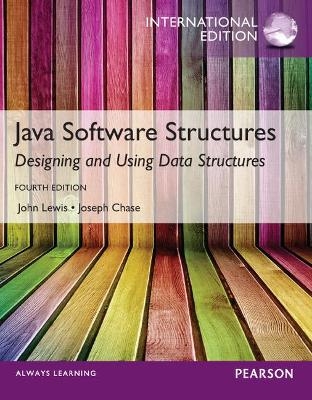
Java Software Structures,International Edition
Pearson Education Limited
978-0-273-79332-8 (ISBN)
- Titel ist leider vergriffen;
keine Neuauflage - Artikel merken
Preface vii
Chapter 1 Introduction 1
1.1 Software Quality 2
Correctness 3
Reliability 3
Robustness 4
Usability 4
Maintainability 5
Reusability 5
Portability 6
Efficiency 6
Quality Issues 6
1.2 Data Structures 7
A Physical Example 7
Containers as Objects 10
Chapter 2 Analysis of Algorithms 15
2.1 Algorithm Efficiency 16
2.2 Growth Functions and Big-Oh Notation 17
2.3 Comparing Growth Functions 19
2.4 Determining Time Complexity 22
Analyzing Loop Execution 22
Nested Loops 22
Method Calls 23
Chapter 3 Introduction to Collections — Stacks 29
3.1 Collections 30
Abstract Data Types 31
The Java Collections API 33
3.2 A Stack Collection 33
3.3 Crucial OO Concepts 35
Inheritance and Polymorphism 36
Generics 37
3.4 Using Stacks: Evaluating Postfix Expressions 38
Javadoc 45
3.5 Exceptions 46
3.6 A Stack ADT 48
3.7 Implementing a Stack: With Arrays 51
Managing Capacity 52
3.8 The ArrayStack Class 53
The Constructors 54
The push Operation 56
The pop Operation 57
The peek Operation 59
Other Operations 59
The EmptyCollectionException Class 59
Other Implementations 60
Chapter 4 Linked Structures — Stacks 67
4.1 R eferences as Links 68
4.2 Managing Linked Lists 70
Accessing Elements 70
Inserting Nodes 71
Deleting Nodes 72
4.3 Elements without Links 73
Doubly Linked Lists 73
4.4 Stacks in the Java API 74
4.5 Using Stacks: Traversing a Maze 75
4.6 Implementing a Stack: With Links 84
The LinkedStack Class 84
The push Operation 88
The pop Operation 90
Other Operations 91
Chapter 5 Queues 97
5.1 A Conceptual Queue 98
5.2 Queues in the Java API 99
5.3 Using Queues: Code Keys 100
5.4 Using Queues: Ticket Counter Simulation 104
5.5 A Queue ADT 109
5.6 A Linked Implementation of a Queue 111
The enqueue Operation 113
The dequeue Operation 115
Other Operations 116
5.7 Implementing Queues: With Arrays 117
The enqueue Operation 121
The dequeue Operation 123
Other Operations 124
5.8 Double-Ended Queues (Deque) 124
Chapter 6 Lists 129
6.1 A List Collection 130
6.2 Lists in the Java Collections API 132
6.3 Using Unordered Lists: Program of Study 133
6.4 Using Indexed Lists: Josephus 144
6.5 A List ADT 146
Adding Elements to a List 147
6.6 Implementing Lists with Arrays 152
The remove Operation 154
The contains Operation 156
The add Operation for an Ordered List 157
Operations Particular to Unordered Lists 159
The addAfter Operation for an Unordered List 159
6.7 Implementing Lists with Links 160
The remove Operation 161
Chapter 7 Iterators 169
7.1 What’s an Iterator? 170
Other Iterator Issues 172
7.2 Using Iterators: Program of Study Revisited 172
Printing Certain Courses 176
Removing Courses 177
7.3 Implementing Iterators: With Arrays 179
7.4 Implementing Iterators: With Links 181
Chapter 8 Recursion 187
8.1 Recursive Thinking 188
Infinite Recursion 188
Recursion in Math 189
8.2 Recursive Programming 190
Recursion versus Iteration 193
Direct versus Indirect Recursion 193
8.3 Using Recursion 194
Traversing a Maze 194
The Towers of Hanoi 202
8.4 Analyzing Recursive Algorithms 207
Chapter 9 Searching and Sorting 215
9.1 Searching 216
Static Methods 217
Generic Methods 217
Linear Searc
| Verlagsort | Harlow |
|---|---|
| Sprache | englisch |
| Maße | 189 x 234 mm |
| Gewicht | 1052 g |
| Themenwelt | Schulbuch / Wörterbuch |
| Informatik ► Software Entwicklung ► Objektorientierung | |
| ISBN-10 | 0-273-79332-2 / 0273793322 |
| ISBN-13 | 978-0-273-79332-8 / 9780273793328 |
| Zustand | Neuware |
| Informationen gemäß Produktsicherheitsverordnung (GPSR) | |
| Haben Sie eine Frage zum Produkt? |